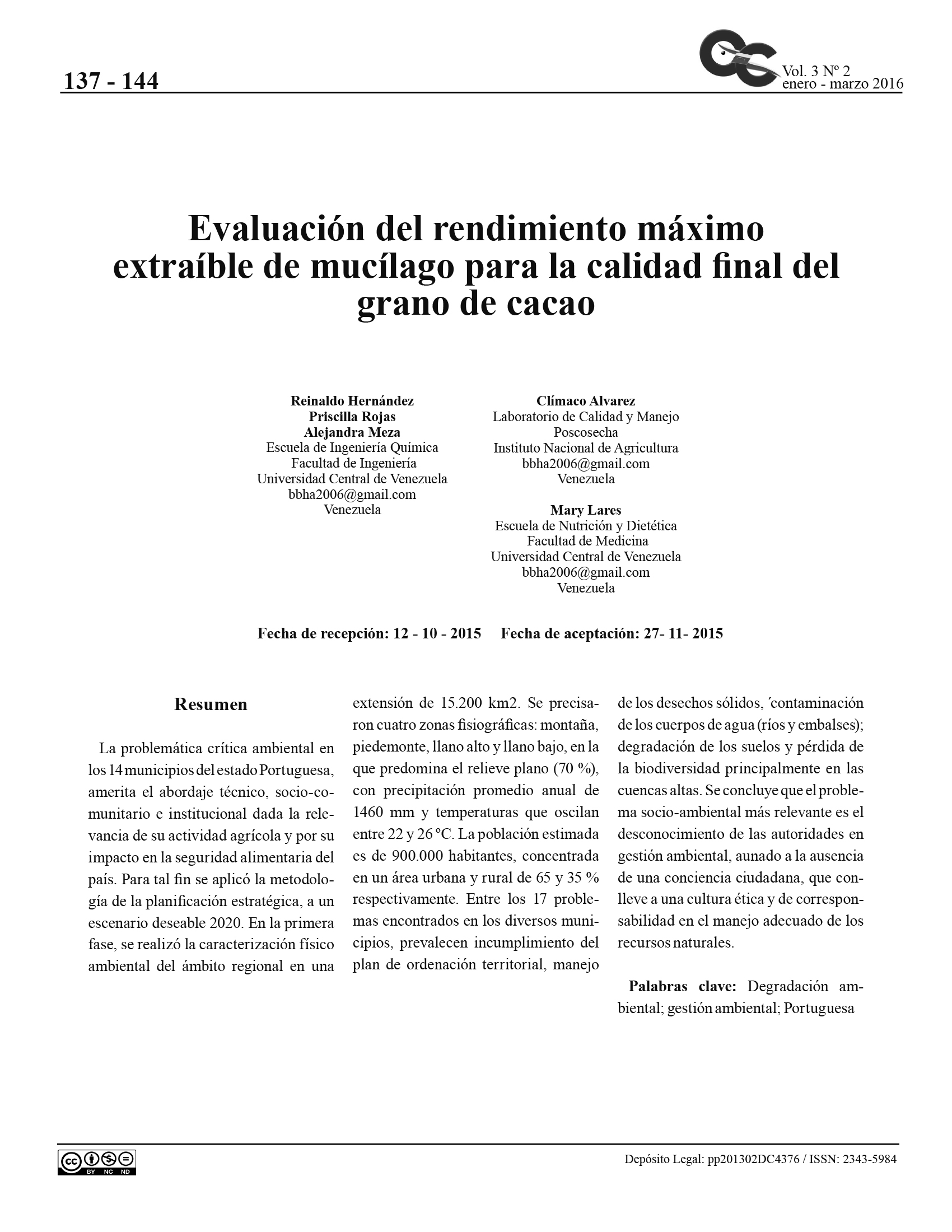Maximum Performance Assessment Mucilage Removable For Final Quality Cocoa Beans
Keywords:
Cocoa, mucilage, pulpAbstract
The cocoa mucilage is the pulp that surrounds the fresh cocoa beans and is of utmost importance as it helps the fermentation process of the beans. In this stage, a great part of the mucilage is lost by natural sloughing. Due to its usefulness and its high nutritional value, the partial extraction of this mucilaginous pulp was considered before the processing, in order to use it as a by-product. It was necessary to evaluate the effect of this extraction on the benefited cocoa bean. The extraction of the mucilage was carried out in different proportions: 15, 30 and 45% (v/v). At the same time, a control sample of fresh almonds was submitted to the benefit process without mechanical deburring. It was carried out the physical and chemical characterization of all the samples of benefited grains and they were compared with the control sample. It was determined the maximum extractable yield of mucilage that did not affect the final quality of the dry cocoa. Finally, it was concluded that the maximum extractable yield of mucilage was 30% (v/v) since no significant changes were observed in the final quality of cocoa beans.
Downloads
References
Álvarez, C., Pérez. E. y Lares, M. (2007). Caracterización física y química de almendras de cacao fermentadas, secas y tostadas cultivadas en la región de Cuyagua, estado Aragua. Agronomía Tropical, 57 (4):249-256.
Álvarez, C., Tovar, L., García, H., Morillo, F., Sánchez, P., Girón, C., y De Farías, A. (2010). Evaluación de la calidad comercial del grano de cacao (Theobroma cacao L.) usando dos tipos de fermentadores. Revista Científica UDO Agrícola, 10(1): 76-87.
Amores, F., Palacios, A., Jiménez, J. y Zhang, D. (2009). Entorno ambiental, genético, atributos de calidad y singularización del cacao en el Nororiente de la provincia de Esmeraldas Instituto Nacional Autónomo de Investigaciones Agropecuarias. Estación Experimental Tropical Pichilingüe. Boletín N° 135. Quevedo, Los Ríos, Ecuador.
Association of Official Analytical Chemist A.O.A.C. (2000). Official methods of analysis. 18va edición. Estados Unidos. pp.1- 17.
Comisión Venezolana de Normas Industriales (COVENIN).
(1995). Granos de cacao, N° 50 (segunda revisión). Venezuela: Ministerio de Fomento.
Comisión Venezolana de Normas Industriales (COVENIN).
(1995). Granos de cacao, N° 442 (2da revisión). Prueba de corte. Venezuela: Ministerio de Fomento. Comisión Venezolana de Normas Industriales
(COVENIN).374-1995. 1995. Granos de cacao, N° 374 (2da revisión). Humedad del grano. Venezuela: Ministerio de Fomento. De la Cruz, P., Osorio, B., Viñas, B., Alamilla, G., Saltijeral, U. (s.f.) Evolución de compuestos no volátiles durante la fermentación del cacao. Recuperado de: http://www.smbb.com.mx/congresos%20smbb/puertovallarta03/ TRABAJOS/AREA_VI/CARTEL/CVI-27.pdf
Leal, F., Serra, A. y Valderrama, E.. (2000). El copoazú (Theobroma grandiflorum) Esterculiácea, pariente del cacao. Memorias del I Congreso Venezolano del Cacao y su Industria.268-274.
Pérez, E., Álvarez, C. y Lares, M. (2002). Caracterización física y química de granos de cacao fermentado, seco y tostado de la región de Chuao. Agronomía Tropical. 52(2): 161-172.
Price, M. y Butler, L. (1977). Rapid visual estimation and spectrophotometric determination of tannin content of sorghum grain. Journal of Agriculture and Food Chemistry, 25: 1268- 1273.
Reyes, H. y De Reyes, C. L. (2000). El cacao en Venezuela. Moderna Tecnología para su cultivo. Venezuela: Edit. Chocolates El Rey.
Vargas, V., Soto, J. y Enríquez, G. (1989). Métodos de fermentación de cacao para pequeños productores en seis localidades de Costa Rica. Pruebas de calidad. En: Memoria seminario regional sobre tecnología poscosecha y calidad mejorada del cacao. Costa Rica: Red regional de generación y transferencia de tecnología en cacao (PROCACAO).

Downloads
Published
How to Cite
Issue
Section
License

This work is licensed under a Creative Commons Attribution-NoDerivatives 4.0 International License.







